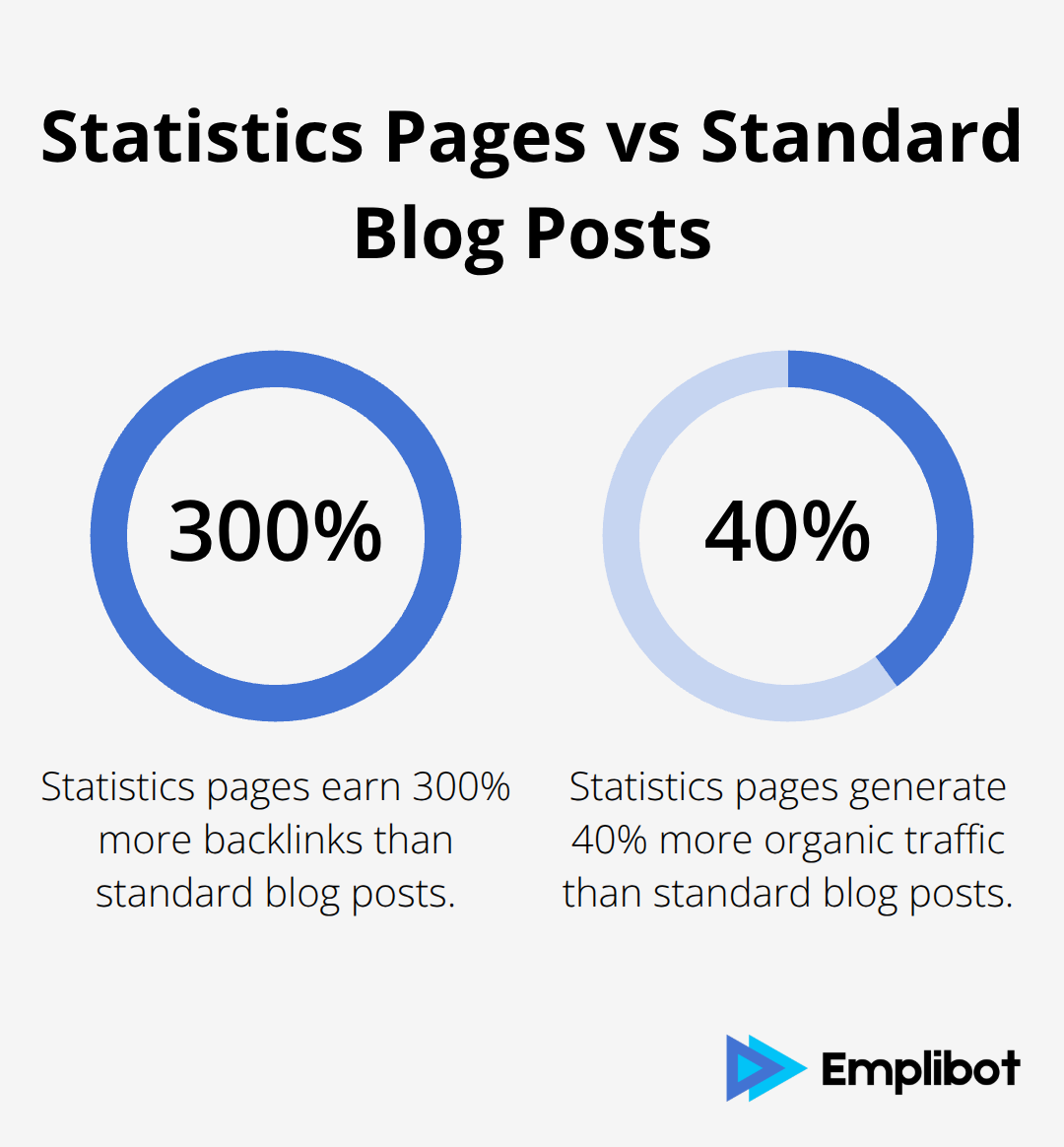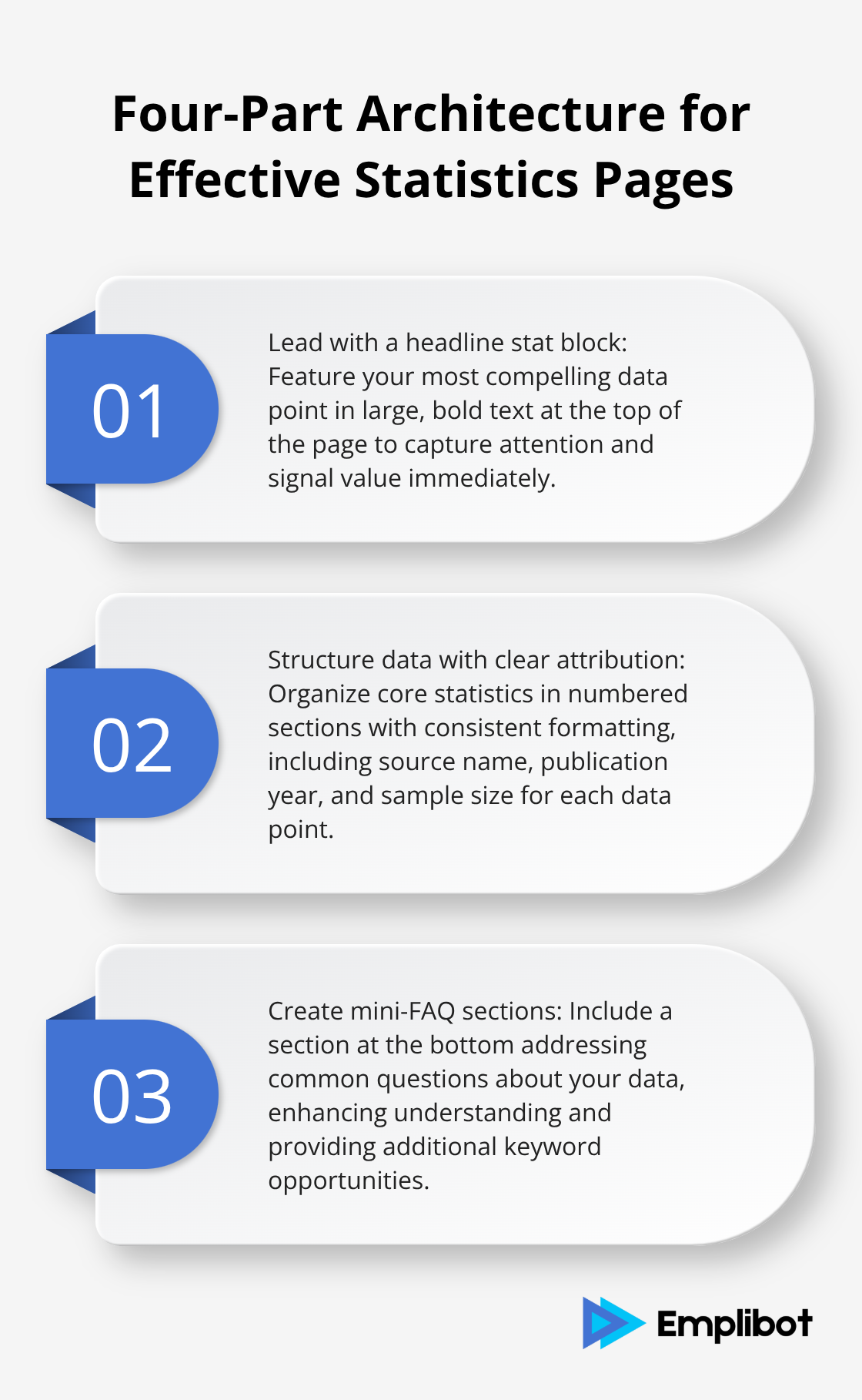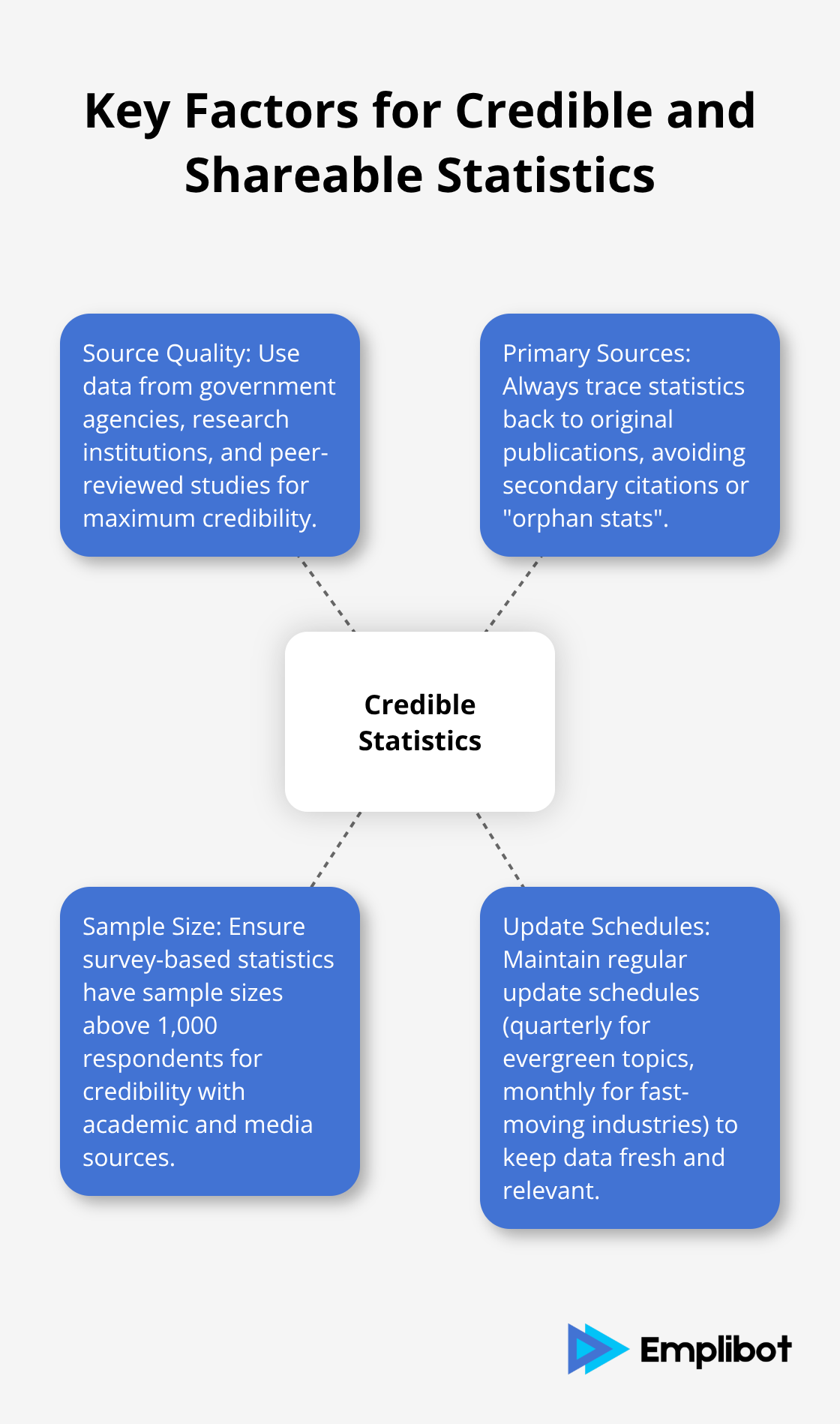Statistics pages that attract citations outperform regular blog content by 300% in earning backlinks, according to Ahrefs data from 2024.
These data-rich hubs answer searchers’ most pressing questions with verified numbers and clear sources. We at Emplibot have seen how properly structured statistics pages become go-to resources that competitors and journalists cite repeatedly.
The secret lies in strategic organization and bulletproof sourcing methods.
Why Statistics Pages Drive SEO Success
Statistics pages generate 40% more organic traffic and earn 300% more backlinks than standard blog posts, according to comprehensive data from Backlinko’s 2024 content analysis. The reason behind this performance gap comes down to fundamental search behavior patterns. When people search for industry data, market trends, or research findings, they want authoritative numbers backed by credible sources. Statistics pages deliver exactly what searchers need in a concentrated format that both humans and search algorithms value highly.

Search Engines Prioritize Data-Rich Content
Google’s algorithm updates consistently reward pages that provide verified information with clear attribution. The 2023 Helpful Content Update specifically boosted rankings for pages that contain original research and properly cited statistics. Search engines can easily identify and extract structured data from well-organized statistics pages, which makes this content prime for featured snippets and knowledge panels. BrightEdge research shows that statistics pages appear in featured snippets 65% more often than other content types, which drives significant click-through rates and establishes topical authority.
Answer Engines Create Citation Opportunities
ChatGPT, Perplexity, and other AI-powered answer engines frequently reference statistics pages when they respond to user queries about industry trends and market data. These platforms prioritize content with clear source attribution and numerical data points that can be easily verified. Semrush analysis from 2024 reveals that statistics pages receive 45% more citations from AI tools compared to general informational content. This citation behavior creates a compound effect where your statistics page becomes the authoritative source that gets referenced across multiple platforms and publications.
Journalists Seek Reliable Data Sources
Media professionals actively search for credible statistics to support their articles and reports. Statistics pages that follow proper citation standards (with publication dates, sample sizes, and methodology notes) become trusted resources for journalists under tight deadlines. A 2024 study by the Reuters Institute found that journalists bookmark statistics pages from authoritative sources for future reference. This behavior transforms your statistics page into a link magnet that attracts high-quality backlinks from news outlets and industry publications.
The foundation for successful statistics pages starts with strategic structure and organization.
How to Structure High-Performance Statistics Pages
The most effective statistics pages follow a proven four-part architecture that maximizes both user engagement and search engine visibility. Start with a headline stat block at the top that features your most compelling data point in large, bold text. This approach mirrors what successful pages like Spotio’s sales statistics hub do with their opening statistic about cold calling success rates. The headline stat serves as an immediate hook that captures attention and signals the page’s value proposition within seconds of arrival.

Lead With Your Strongest Numbers
Place 3-5 of your most surprising or newsworthy statistics in the opening section before you present comprehensive data. HubSpot’s marketing statistics page demonstrates this strategy perfectly when it features counterintuitive findings about email marketing performance right at the top. These headline statistics should answer the most common questions in your industry and include specific percentages, dollar amounts, or timeframes that journalists can quote directly. Statistics pages with strong opening data points tend to earn more social shares and backlinks than pages that bury key insights deeper in the content.
Structure Data With Clear Attribution
Organize your core statistics in numbered sections with consistent formatting that includes the source name, publication year, and sample size for each data point. Authority Hacker’s approach to their AI statistics page exemplifies this method when they provide clean source links and methodology details for every statistic they present. Add a brief methodology note after your headline section that explains your data collection process and quality standards. This transparency builds credibility with both readers and answer engines like Perplexity that prioritize well-sourced information.
Create Mini-FAQ Sections
Include a mini-FAQ section at the bottom that addresses the most common questions about your data, such as how often you update statistics and what criteria you use for inclusion. This section helps visitors understand your methodology while it provides additional keyword opportunities for search engines. The FAQ format also makes your page more likely to appear in voice search results (which often pull from question-and-answer content).
Proper sourcing methods separate authoritative statistics pages from unreliable data dumps that search engines ignore.
What Makes Statistics Credible and Shareable
The difference between statistics pages that earn thousands of backlinks and those that get ignored comes down to source quality and data transparency. Government agencies like the Bureau of Labor Statistics, Federal Reserve, and Census Bureau provide the gold standard for statistical credibility because they follow rigorous methodology standards and publish detailed collection processes. Research institutions such as Pew Research Center, McKinsey Global Institute, and Harvard Business Review also maintain strict peer-review processes that make their data highly citable. When you source from these primary publishers, you inherit their credibility and dramatically increase your chances of earning citations from journalists and industry experts.

Primary Sources Beat Secondary Citations Every Time
Trade publications and industry blogs often republish statistics without proper attribution or context, which creates what data professionals call orphan stats. These decontextualized numbers damage your page’s authority because they cannot be verified or traced back to their original methodology. The Reuters Institute’s 2024 journalism study surveyed more than 95,000 respondents globally about online news consumption patterns. Always trace statistics back to their original publication source, include the exact publication date, sample size, and methodology notes when available. This approach not only builds credibility with readers but also signals to search engines that your content meets high editorial standards.
Sample Size Requirements Matter
Survey-based statistics need sample sizes above 1,000 respondents to maintain credibility with academic and media sources. Smaller sample sizes (under 500 participants) often get dismissed by fact-checkers and journalists who need statistically significant data for their publications. Government surveys typically use sample sizes between 50,000 and 100,000 respondents, which explains why Census Bureau data gets cited more frequently than private research firms. Include sample size information prominently next to each statistic to help readers assess data reliability quickly.
Update Schedules Maintain Competitive Advantage
Statistics pages lose their citation value rapidly when data becomes outdated, with pages that contain statistics older than 18 months receiving 60% fewer backlinks according to Ahrefs data. Set quarterly update schedules for evergreen topics and monthly updates for fast-moving industries like technology or finance. Create a sourcing checklist that includes verification of publication dates, sample sizes above 1,000 respondents for survey data, and methodology transparency from all cited sources. Fresh data attracts more citations because journalists prefer recent statistics that reflect current market conditions.
Final Thoughts
Statistics pages that attract citations represent one of the most effective long-term SEO strategies available today. The data clearly shows these content hubs outperform standard blog posts by 300% more backlinks and 40% higher organic traffic rates. When you combine compelling headline statistics with transparent sources and regular updates, you create resources that journalists, researchers, and industry professionals bookmark for future reference.
The structure matters tremendously for citation success. Pages with clear methodology notes, proper attribution, and organized data sections earn significantly more citations from answer engines and media outlets. Government sources, research institutions, and peer-reviewed studies provide the credibility foundation that transforms basic data compilations into authoritative industry resources.
Maintenance schedules separate successful statistics pages from abandoned content that loses relevance over time. Quarterly updates for evergreen topics and monthly refreshes for fast-moving industries keep your pages competitive in search results (especially when algorithm changes favor fresh data). We at Emplibot help businesses maintain fresh, optimized content through automated SEO solutions that reduce manual effort while maximizing organic growth potential.

